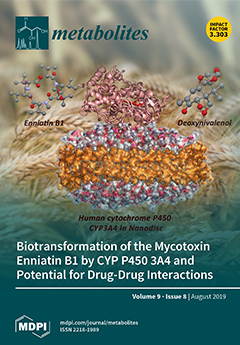Open AccessArticle
Bronchoalveolar Lavage Fluid from COPD Patients Reveals More Compounds Associated with Disease than Matched Plasma
by
Eitan Halper-Stromberg, Lucas Gillenwater, Charmion Cruickshank-Quinn, Wanda Kay O’Neal, Nichole Reisdorph, Irina Petrache, Yonghua Zhuang, Wassim W. Labaki, Jeffrey L. Curtis, James Wells, Stephen Rennard, Katherine A. Pratte, Prescott Woodruff, Kathleen A. Stringer, Katerina Kechris and Russell P. Bowler
Cited by 32 | Viewed by 6097
Abstract
Smoking causes chronic obstructive pulmonary disease (COPD). Though recent studies identified a COPD metabolomic signature in blood, no large studies examine the metabolome in bronchoalveolar lavage (BAL) fluid, a more direct representation of lung cell metabolism. We performed untargeted liquid chromatography–mass spectrometry (LC–MS)
[...] Read more.
Smoking causes chronic obstructive pulmonary disease (COPD). Though recent studies identified a COPD metabolomic signature in blood, no large studies examine the metabolome in bronchoalveolar lavage (BAL) fluid, a more direct representation of lung cell metabolism. We performed untargeted liquid chromatography–mass spectrometry (LC–MS) on BAL and matched plasma from 115 subjects from the SPIROMICS cohort. Regression was performed with COPD phenotypes as the outcome and metabolites as the predictor, adjusted for clinical covariates and false discovery rate. Weighted gene co-expression network analysis (WGCNA) grouped metabolites into modules which were then associated with phenotypes. K-means clustering grouped similar subjects. We detected 7939 and 10,561 compounds in BAL and paired plasma samples, respectively. FEV
1/FVC (Forced Expiratory Volume in One Second/Forced Vital Capacity) ratio, emphysema, FEV
1 % predicted, and COPD exacerbations associated with 1230, 792, eight, and one BAL compounds, respectively. Only two plasma compounds associated with a COPD phenotype (emphysema). Three BAL co-expression modules associated with FEV
1/FVC and emphysema. K-means BAL metabolomic signature clustering identified two groups, one with more airway obstruction (34% of subjects, median FEV
1/FVC 0.67), one with less (66% of subjects, median FEV
1/FVC 0.77;
p < 2 × 10
−4). Associations between metabolites and COPD phenotypes are more robustly represented in BAL compared to plasma.
Full article
►▼
Show Figures






